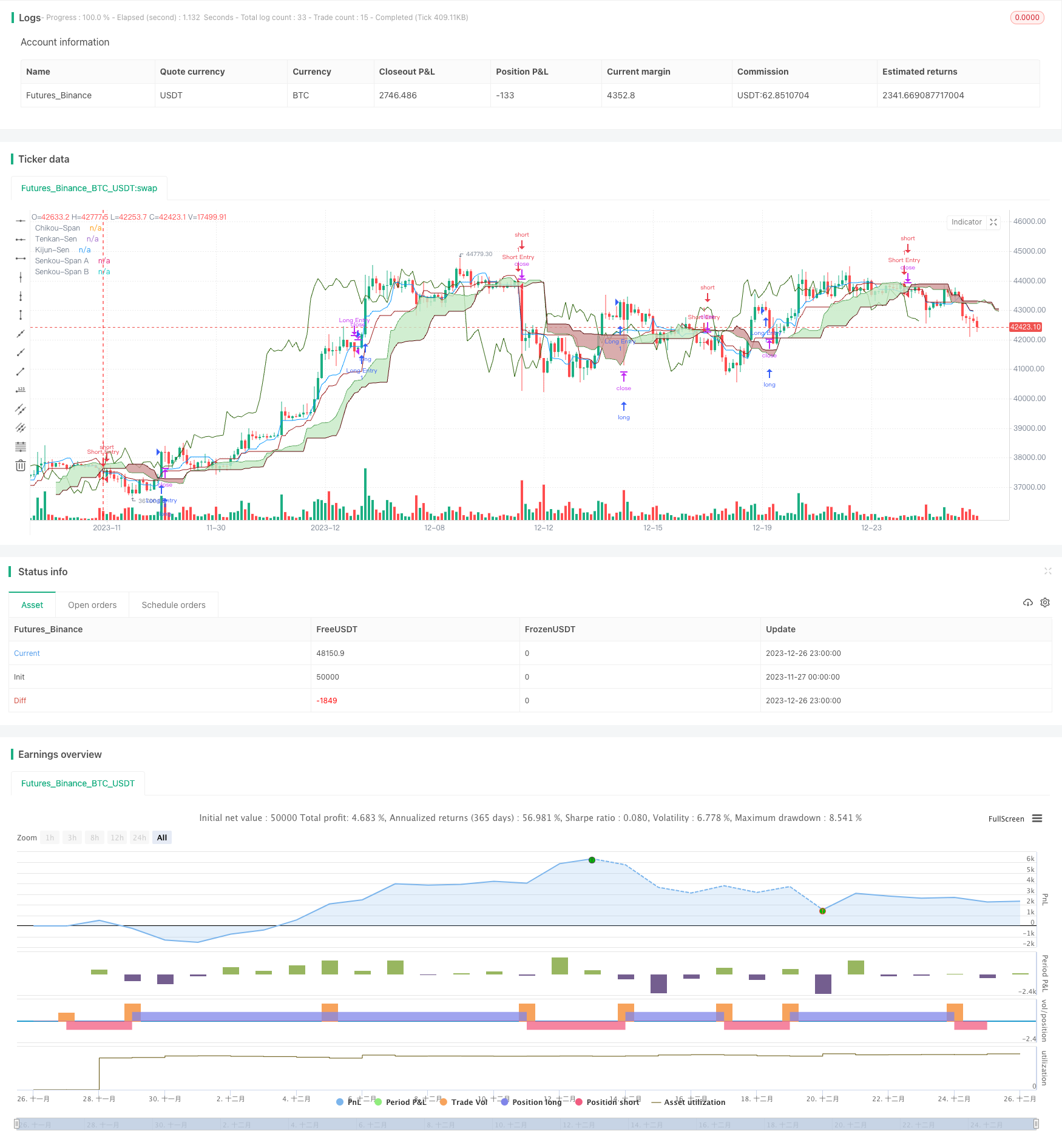
概述
该策略是在一目均衡交易系统的基础上改进而成的。主要思想是结合均线理论指标一目均衡以及资金管理规则,实现短线和多头交易机会的识别。
策略原理
策略使用经典的一目均衡系统作为基本参考。主要组成部分包括:
转向线:中期线。反映中期趋势。
基准线:长期线。反映长期趋势。
先行线:未来预测线。反映未来趋势。
滞后线:过去线。反映过去趋势。
在此基础上,策略进行了如下改进:
时间参数选择遵循奇数平方理论,使其更符合市场规律。
增加资金管理规则,包括止损、止盈、头寸规模等,控制交易风险。
可调整回测范围,使策略测试更全面。
具体来说,多头入场条件包括转向线上穿基准线、滞后线高于价格、价格高于云图、云图未来预测牛市等。空头入场条件则要求转向线下穿基准线、滞后线低于价格等。
资金管理规则则要求多头止盈30%、止损5%;空头止损超过转向线3倍ATR时止损。
优势分析
该策略结合均线指标和资金管理的优势主要体现在:
一目均衡系统本身反映短中长期趋势, entry/exit 合理。
奇数平方理论优化参数,符合市场统计规律。
资金管理规则有效控制单笔止损,确保盈利大于止损。
回测范围可调整,测试更全面ROUND。
综上,该策略综合考虑趋势、参数选择、风险控制等多方面因素,能够有效识别短多机会,控制交易风险,具有很强的实用性。
风险分析
该策略的主要风险来自以下几个方面:
一目均衡系统容易被假突破愚弄,造成不必要入场。可以结合更多指标过滤信号。
固定止盈止损规则容易被套,可以引入动态止损止盈。
回测数据不全面,可能高估策略效果。需要更长时间和更多市场的回测。
该策略更适合趋势市,盘整市表现可能不佳。可以优化入场条件以识别趋势。
优化方向
该策略主要可以从以下几个方面进行优化:
增加指标过滤,提高入场质量。比如MACD,KDJ等辅助判断指标。
动态止盈止损。比如突破均线N倍ATR进行止盈,跌破支持位止损。
多品种回测验证。在更多市场和更长的数据上验证策略稳定性。
区分趋势和盘整市场。优化入场机制,使之能适应不同行情。
总结
该策略综合考虑趋势、资金管理等多方面因素,使用一目均衡指标识别短线多头交易机会;同时使用风险控制规则控制单笔损失。相比原始一目均衡系统有了很大改进。通过进一步优化,该策略有望成为一个非常实用的短多策略。
/*backtest
start: 2023-11-27 00:00:00
end: 2023-12-27 00:00:00
period: 3h
basePeriod: 15m
exchanges: [{"eid":"Futures_Binance","currency":"BTC_USDT"}]
*/
// Author Obarut
//@version=5
strategy("İchimoku Strategy With MM Short-Long",overlay=true,process_orders_on_close=true)
//Ichimoku Inputs
ts_period = input.int(8, minval=1, title="Tenkan-Sen Period")
ks_period = input.int(16, minval=1, title="Kijun-Sen Period")
ssb_period = input.int(24, minval=1, title="Senkou-Span B Period")
cs_offset = input.int(16, minval=1, title="Chikou-Span Offset")
ss_offset = input.int(8, minval=1, title="Senkou-Span Offset")
long_entry = input(true, title="Long Entry")
short_entry = input(true, title="Short Entry")
// Back Testing Period Inputs
fromday = input.int(defval=1,title="Start Date",minval=1,maxval=31)
frommonth = input.int(defval=1,title="Start Month",minval=1,maxval=12)
fromyear = input.int(defval=1980,title="Start Year",minval=1800, maxval=2100)
today = input.int(defval=1,title="En Date",minval=1,maxval=31)
tomonth = input.int(defval=1,title="End Month",minval=1,maxval=12)
toyear =input.int(defval=2100,title="End Year",minval=1800,maxval=2200)
start=timestamp(fromyear,frommonth,fromday,00,00)
finish=timestamp(toyear,tomonth,today,00,00)
timewindow= time>=start and time<=finish
//Ichimoku Componenets Calculation Function
middle(len) => math.avg(ta.lowest(len), ta.highest(len))
// Ichimoku Components
tenkan = middle(ts_period)
kijun = middle(ks_period)
senkouA = math.avg(tenkan, kijun)
senkouB = middle(ssb_period)
//Senkou Span Lines slopes
slopetenkan=(tenkan-tenkan[2])/tenkan
slopekijun= (kijun-kijun[2])/kijun
//Avarage True Range
atr = ta.atr(14)
//Senkou Span Lines
ss_above = math.max(senkouA[ss_offset-1], senkouB[ss_offset-1])
ss_below = math.min(senkouA[ss_offset-1], senkouB[ss_offset-1])
// Price Distance From Tenkan
distance = close - tenkan
// Price Distance from Kijun
distancek = close - kijun
// Entry/Exit Signals
tk_cross_kijun_bull = tenkan >= kijun//Tenkan Sen is greater than or equal to Kijun Sen
tk_cross_kijun_bear = tenkan <= kijun//Tenkan Sen is smaller than or equal to Kijun Sen
cs_cross_bull = close > high[cs_offset-1]//Chikou is above the price
cs_cross_bear = close < close[cs_offset-1]//Chikou is below the price
price_above_kumo = close > ss_above//Price is above the Kumo cloud
pbsenkA = close < ss_above // Price is below the Senkou Span which is higher
pasenkB = close > ss_below// Price is above the Senkou span which is lower
price_below_kumo = close < ss_below // Price is below Kumo cloud
future_kumo_bull = senkouA > senkouB and (ta.roc(senkouA,3)>0) and (ta.roc(senkouB,3)>=0) // Future Kumo cloud is bullish
pbtenkan=close<tenkan
tkbelowkij=tenkan<kijun
future_kumo_bear = senkouA < senkouB//Future Kumo cloud is bearish
// Price Distance From Tenken
disbull = distance < 2*atr
//Price Distance From Kijun
disbullk = distancek < 3*atr
//Price Above Tenkan Condition
patk = close > tenkan
// Kijun Above Senkou Span Condition
kjasenkA = kijun > ss_above
// Price Below Kijun Condition
pbkijun = close < kijun
//Consolidation Tenkan and Kijun are inside Kumo cloud
kijuninsidekumo= kijun<ss_above and kijun>ss_below
tenkaninsidekumo= tenkan<ss_above and tenkan>ss_below
consolidation=kijuninsidekumo and tenkaninsidekumo
//Bullish Entry Condition
bullish= tk_cross_kijun_bull and cs_cross_bull and price_above_kumo and future_kumo_bull and disbull and patk
and not consolidation
//Bullish exit
bearish=tk_cross_kijun_bear and pbsenkA and cs_cross_bear and future_kumo_bear
or price_below_kumo
// Bearish Entry Condition
bearish2=tk_cross_kijun_bear and pbtenkan and tkbelowkij and tkbelowkij and cs_cross_bear and future_kumo_bear
if(bullish and timewindow and long_entry )
strategy.entry("Long Entry", strategy.long)
if(bearish2 and timewindow and short_entry)
strategy.entry("Short Entry",strategy.short)
// Bearish Condition
lastentryprice = strategy.opentrades.entry_price(strategy.opentrades - 1)
// Take Profit or Stop Loss in Bearish
exit1= (close-tenkan)>3*atr and slopetenkan<=0
exit2= (close-lastentryprice)>5*atr and close<(tenkan-0.04*atr)
if(bearish and timewindow and not short_entry or exit1 or exit2 or (close>1.30*lastentryprice ) or (close< 0.95*lastentryprice))
strategy.close("Long Entry")
if(bullish and timewindow and not long_entry)
strategy.close("Short Entry")
if(time>finish)
strategy.close_all("time up")
plot(tenkan, color=#0496ff, title="Tenkan-Sen")
plot(kijun, color=#991515, title="Kijun-Sen")
plot(close, offset=-cs_offset+1, color=#2e640e, title="Chikou-Span")
sa=plot(senkouA, offset=ss_offset-1, color=color.rgb(17, 122, 21), title="Senkou-Span A")
sb=plot(senkouB, offset=ss_offset-1, color=color.rgb(88, 8, 8), title="Senkou-Span B")
fill(sa, sb, color = senkouA > senkouB ? color.rgb(198, 234, 198) : color.rgb(208, 153, 153), title="Cloud color")